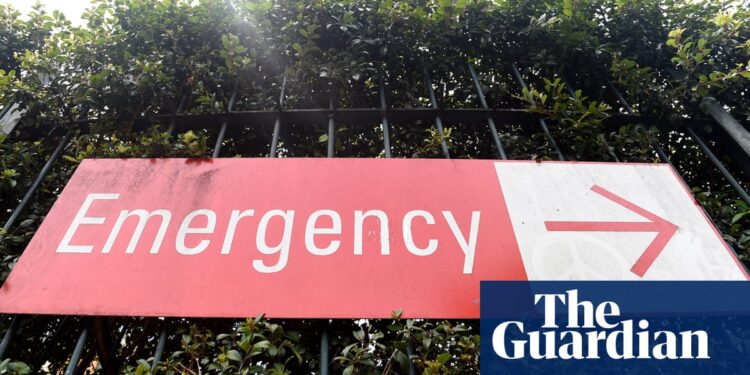A psychiatric patient having hallucinations waited in a major Sydney emergency department for more than five days amid an ongoing dispute between New South Wales and its psychiatrists.
A patient list from a major inner-city hospital on Monday morning showed the six patients experiencing the highest wait times were all psychiatric patients. The evidence provided by the source had been anonymised.
As of Monday morning, one patient had waited in the ED for more than 130 hours – or more than five days. Three other patients all having psychotic episodes had also waited days – one 87 hours and 52 minutes, one 64 hours and 29 minutes, and another 53 hours.
Another patient at risk of suicide waited 25 hours, and a sixth with a manic disorder had waited more than 16 hours.
Guardian Australia understands the resignations of two psychiatrists at that hospital have come into effect.
The state government has been involved in a high-profile industrial relations dispute with psychiatrists who have threatened mass resignations.
Staff specialist psychiatrists – who work in permanent roles in public hospitals – claim they are paid less than psychiatrists in other states and say the pay difference has led to staff shortages and challenges in recruiting staff, making working conditions potentially riskier as more positions go unfilled.
A spokesperson for that hospital said it was “committed to providing safe, timely access to healthcare for all patients. We thank our highly skilled and dedicated workforce who continue to perform exceptionally. Anyone experiencing mental health distress or concerns should reach out at any time for help and care. Help is available if you need it”.
“It is important to note a patient’s length of stay (LOS) in the emergency department (ED) doesn’t correlate with the time taken for a person to be assessed and/or for treatment to commence. While the patient is in the ED, they are assessed, triaged, and treatment is commenced.”
Psychiatrist Dr Kamran Ahmed said waiting for longer than necessary in the often “chaotic” environment of an emergency department can be further detrimental to patients’ mental health, and waiting for days was “unacceptable”, as it could risk a further deterioration of their condition.
“When people present with a mental health emergency, they can be distressed and agitated. The emergency department can be very busy and noisy, which can exacerbate their symptoms further,” Ahmed said.
“They’re potentially suffering for longer than they should be because they’re not getting the right treatment in the right environment, or the right kind of support.”
Across the state the shortage of psychiatrists and inpatient mental health beds is “almost certainly” having an impact on waiting times, he said.
Guardian Australia has also seen anonymised patient emergency department wait times for a different large hospital in the city’s west from 28 January which showed a psychiatric patient with schizophrenia waiting 87 hours and 54 minutes, while another patient with suicidal ideation had waited 85 hours and 56 minutes.
A total of 12 psychiatric patients at that hospital had wait times of more than 24 hours that day, with most appearing beside the shorthand “MH NBA” meaning mental health no bed available.
Ideally patients should be seen by the emergency department team, then assessed by the mental health team in a timely manner, and if they decide the patient requires admission “they should be transferred to a bed without delay”, Ahmed said.
In the psychiatric ward, patients are monitored and supported by mental health nurses and regularly reviewed by psychiatrists who provide management plans including medication when needed, Ahmed said.
By contrast, the emergency department is a “holding measure, and they do not receive the same level of specialist mental health care.”







